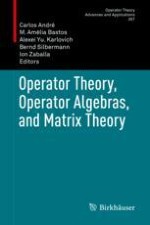This book consists of invited survey articles and research papers in the scientific areas of the “International Workshop on Operator Algebras, Operator Theory and Applications,” which was held in Lisbon in July 2016. Reflecting recent developments in the field of algebras of operators, operator theory and matrix theory, it particularly focuses on groupoid algebras and Fredholm conditions, algebras of approximation sequences, C* algebras of convolution type operators, index theorems, spectrum and numerical range of operators, extreme supercharacters of infinite groups, quantum dynamics and operator algebras, and inverse eigenvalue problems.
Establishing bridges between the three related areas of operator algebras, operator theory, and matrix theory, the book is aimed at researchers and graduate students who use results from these areas.
